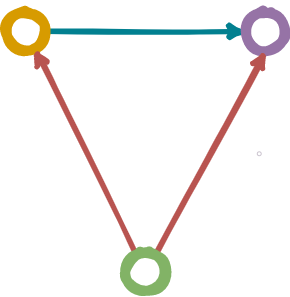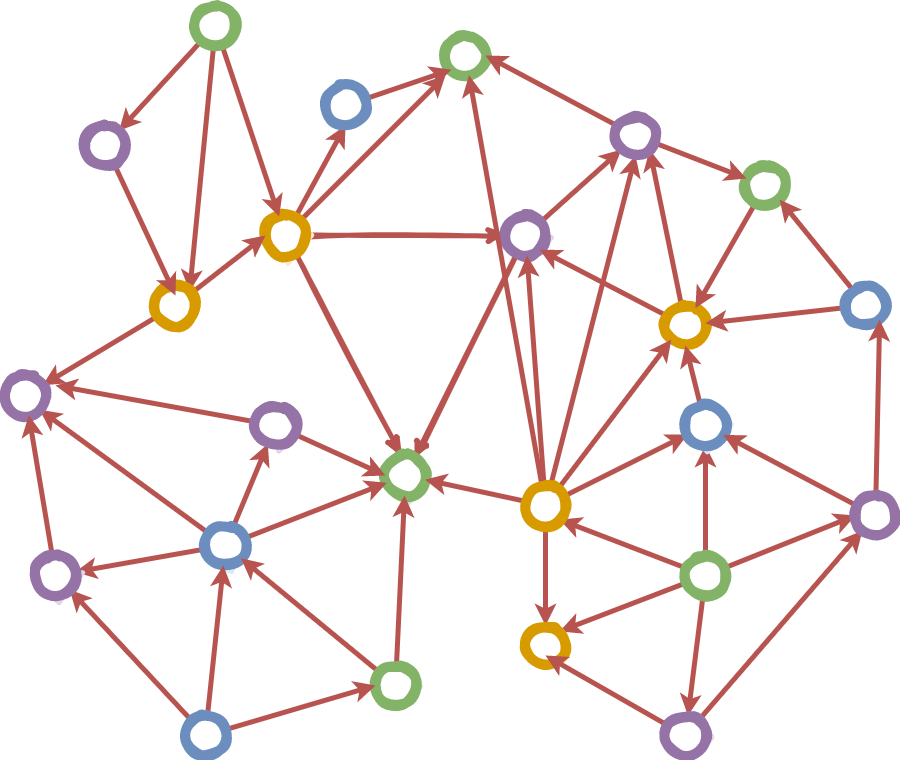
open import Agda.Primitive using (Level; _⊔_; lsuc; lzero)
open import Types.product
open import Types.relations
open import Types.equality
module Category.category whereA category is the object of study in category theory. It can be thought of being a bunch of objects, which are associated by a bunch of arrows between those objects, with the arrows being composable and each object having unit arrows. This minimal structure ensures a multitude of object types studied in mathematics can fit the description.
A category ℂ consists of:
such that:
If \[f : a → b, g : b → c\] then \[g ∘ f : a → c\]
\[If~~ f : a → b,~ g : b → c ~~and~~ h : c → d ~~then~~ h ∘ (g ∘ f) = (h ∘ g) ∘ f\]

record Category (o ℓ e : Level) : Set (suc (o ⊔ ℓ ⊔ e)) where
infix 4 _≈_ _⇒_
infixr 9 _∘_
field
Obj : Set o -- objects
_⇒_ : Rel Obj ℓ -- morphism
_≈_ : ∀ {A B} → Rel (A ⇒ B) e -- equivalence of morphisms
id : ∀ {A} → (A ⇒ A) -- identity
-- composition of morphisms
_∘_ : ∀ {A B C} → (B ⇒ C) → (A ⇒ B) → (A ⇒ C)
-- laws
-- satisfy associativity
assoc : ∀ {A B C D} {f : A ⇒ B} {g : B ⇒ C} {h : C ⇒ D} → (h ∘ g) ∘ f ≈ h ∘ (g ∘ f)
-- satisfy identity
identityˡ : ∀ {A B} {f : A ⇒ B} → id ∘ f ≈ f
identityʳ : ∀ {A B} {f : A ⇒ B} → f ∘ id ≈ f
-- has an equivalence for morphisms
equiv : ∀ {A B} → IsEquivalence (_≈_ {A} {B})
-- composition is congruent on equivalence
∘-resp-≈ : ∀ {A B C} {f h : B ⇒ C} {g i : A ⇒ B} → f ≈ h → g ≈ i → f ∘ g ≈ h ∘ iThe machinery of category theory also admits a duality, like an object and its mirror image. The opposite or dual of a category \(ℂ\), denoted by \(ℂᴼᵖ\), is the same category, but with all morphisms in the opposite direction. All laws and machinery of category theory have their dual versions.
record Categoryᴼᵖ (o ℓ e : Level) : Set (suc (o ⊔ ℓ ⊔ e)) where
infix 4 _≈_ _⇒_
infixr 9 _∘_
field
Obj : Set o -- objects
_⇒_ : Rel Obj ℓ -- morphism
_≈_ : ∀ {A B} → Rel (B ⇒ A) e -- equivalence of morphisms
id : ∀ {A} → (A ⇒ A) -- identity
-- composition of morphisms
_∘_ : ∀ {A B C} → (B ⇒ A) → (C ⇒ B) → (C ⇒ A)
-- laws
-- satisfy associativity
assoc : ∀ {A B C D} {f : A ⇒ B} {g : B ⇒ C} {h : C ⇒ D} → h ∘ (g ∘ f) ≈ (h ∘ g) ∘ f
-- satisfy identity
identityˡ : ∀ {A B} {f : A ⇒ B} → id ∘ f ≈ f
identityʳ : ∀ {A B} {f : A ⇒ B} → f ∘ id ≈ f
-- has an equivalence for morphisms
equiv : ∀ {A B} → IsEquivalence (_≈_ {A} {B})
-- composition is congruent on equivalence
∘-resp-≈ : ∀ {A B C} {f h : B ⇒ C} {g i : A ⇒ B} → g ≈ i → f ≈ h → g ∘ f ≈ i ∘ hWe can use various mathematical structures to construct categories out of. When defining a category, we have to decide what our objects and our morphisms would be and how would the morphisms compose. This decision has to be taken in a way that the conditions of being a category are satisfied (associativity, identity). We would then have a category of our chosen object.
A category of sets is the simplest of categories we can construct and the most intuitive to understand given we have been trained to think in terms of sets.
Here are some other examples:
| Category | Objects | Morphisms |
|---|---|---|
| Set | sets | total functions |
| Group | groups | group homomorphisms |
| Top | topological spaces | continuous functions |
| Vectₖ | vector spaces over field K | linear transformations |
| Poset | partially ordered sets | order-preserving functions |
| TopVect | topological vector spaces | continuous linear maps |
| 𝕄 | differentiable manifolds | differentiable maps |
| Banach spaces | open subsets of Banach spaces | differentiable maps |
| 𝕍 | vector bundles | vector bundle maps |
There are in fact infinitely many more and so we are going to move along now.
Before explaining higher categories, let us look at a structure from algebraic topology called simplexes and simplicial complexes.
A simplex is an n-dimensional “triangle”. Some examples of the first few dimensional simplices are:
An n-dimensional simplex is also called an (n+1)-cell.

A simplicial complex is a structure formed by gluing together a bunch of simplices. The gluing process has to follow a set of properties:
A set of simplices \(\mathcal{K}\) is a simplicial complex if: - Every face of a simplex from \(\mathcal{K}\) is also in \(\mathcal{K}\) - Intersections of any two simplices is a face of both the simplices
A simplicial complex is of dimension n if the largest dimension of all the constituent simplices is n.
\[ dim(\mathcal{K}) = max(dim(σ_i)) \]
Examples:
Simplicial complexes can be used to create or represent topological spaces and serve as a very useful tool. They can also be used to formalize algebraic constraints in geometric terms as well.
The Nerve N(ℂ) of a category ℂ is a simplicial complex constructed from objects as vertices of simplices and morphisms of ℂ as the edges.

Given two (or more) categories, their cartesian product is also a category.
Given two categories ℂ and 𝔻, their product is a category with: - Pairs (C, D) as objects such that C ∈ ℂ and D ∈ 𝔻 - (f, g) as morphisms where - \(f : C_1 → C_2; C_i ∈ ℂ\) - \(g : D_1 → D_2; D_i ∈ 𝔻\) - composition of morphisms defined as \((f_1, g_1) ∘ (f_2, g_2) = (f_1 ∘ f_2, g_1 ∘ g_2)\) - identities defined as \(1_{(C, D)} = (1_C, 1_D)\)
Free categories are a result of using a general pattern called “free constructions” for building categories. The idea of free objects in mathematics can be related to all types of objects with algebraic structure, and provides a general method of constructing objects using a set of “constructor” objects. The process of construction proceeds as follows:
For free categories these rules become: